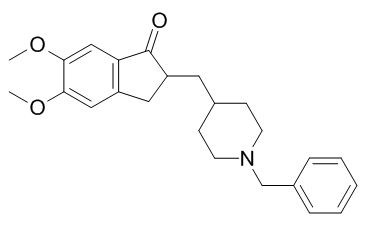All AbMole products are for research use only, cannot be used for human consumption.

Donepezil(E 2020) is a specific and potent AChE inhibitor for bAChE and hAChE with IC50 of 8.12 nM and 11.6 nM, respectively.
Donepezil has reversible and noncompetitive inhibition effects on AChE. It has 500-1000-fold more selective for AChE over butyrylcholinesterase (BuChE). Short- and long-exposure of SH-SY5Y human neuroblastoma cells to donepezil induces a concentration-dependent inhibition of cell proliferation unrelated to muscarinic or nicotinic receptor blockade or apoptosis. Donepezil reduces the number of cells in the S-G2/M phases of the cell cycle, increases the G0/G1 population, and reduces the expression of two cyclins of the G1/S and G2/M transitions, cyclin E and cyclin B, in parallel with an increase in the expression of the cell cycle inhibitor p21.
Donepezil is metabolized in the liver via the cytochrome P450 system (CYP1A2-, CYP2D6-, CYP3A4-related enzymes). In animals, donepezil is found unchanged in brain, and no metabolites are detected in the nervous tissue. In plasma, urine, and bile, most donepezil metabolites are O-glucuronides. After oral ingestion, peak plasma concentrations are achieved in 3-5 hours and its absortion is not affected by food. Donepezil has linear pharmacokinetics over a dose range of 1-10 mg/day. 96% of circulating donepezil is protein bound.
| Cell Experiment | |
|---|---|
| Cell lines | retinal ganglion cells (RGCs) |
| Preparation method | RGC survival after exposure to each reagent (glutamate, donepezil, tacrine, galanthamine, and HA14-1) is measured by calcein-AM staining after 3 days in culture, Briefly, cells are incubated in 1 μM calcein-AM in PBS for 15 minutes at 37℃. After the medium is replaced with fresh PBS, cells are examined under a fluorescence microscope using a fluorescein filter. The total number of surviving RGCs defined as cells with a calcein-AM stained cell body and a process extending at least two cell diameters from the cell body is counted in each well. The number of surviving RGCs without any drug served as a control. |
| Concentrations | 100 nM-10 μM |
| Incubation time | 3 days |
| Animal Experiment | |
|---|---|
| Animal models | Age-matched (10-12 weeks old, 21–24 g) male C57BL/6 wild-type and CGRP(−/−) mice |
| Formulation | added to the food powder |
| Dosages | 1.5 mg/kg |
| Administration | oral |
| Molecular Weight | 379.49 |
| Formula | C24H29NO3 |
| CAS Number | 120014-06-4 |
| Solubility (25°C) | DMSO: 70 mg/mL |
| Storage |
Powder -20°C 3 years ; 4°C 2 years In solvent -80°C 6 months ; -20°C 1 month |
| Related AChR/AChE Products |
|---|
| Methoctramine tetrahydrochloride
Methoctramine tetrahydrochloride is a potent and cardioselectivity antagonist of M2 muscarinic receptor. |
| AT 1001
AT 1001 is a high-affinity and selective antagonist of the α3β4 nicotinic acetylcholine receptor (α3β4 nAChR) with Ki of 2.64 nM. |
| Dihydro-β-erythroidine hydrobromide
Dihydro-β-erythroidine hydrobromide is a potent, orally active, and competitive antagonist of neuronal nAChRs. Dihydro-β-erythroidine hydrobromide shows selectivity for α4β4 and α4β2 nAChRs, with IC50s of 0.19 and 0.37 μM, respectively. |
| Spinosad
Spinosad, a mixture of spinosyns A and D known as fermentation products of a soil actinomycete (Saccharopolyspora spinosa), is a biological neurotoxic insecticide with a broader action spectrum. Spinosad targets the nicotinic acetylcholine receptor (nAChRs) of the insect nervous system. |
| TAE-1
TAE-1 is a potent inhibitor of AChE and BuChE. |
All AbMole products are for research use only, cannot be used for human consumption or veterinary use. We do not provide products or services to individuals. Please comply with the intended use and do not use AbMole products for any other purpose.


Products are for research use only. Not for human use. We do not sell to patients.
© Copyright 2010-2024 AbMole BioScience. All Rights Reserved.
